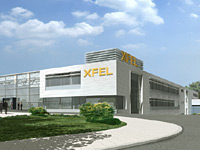
Artist's impression of the experiment buildings of the future European XFEL project at DESY in Germany. |

A view into the existing FLASH-tunnel. |
High-energy physics is a lot like family. At university you are born into it, your thesis supervisor parents have a great influence on you, you always stay close to your brothers and sisters, even though they annoy you sometimes. It's always there with you, it's in your blood, you can never forget it completely. You get partner-institute in-laws, go to family reunion meetings and see your summer student children grow up. The particles you study have their own little mysterious families. And even accelerators have big and small brothers, cousins, parents and grandchildren.
If the European X-ray Free Electron Laser that will start running at DESY in Hamburg, Germany, in 2013, is an adolescent about to enter adulthood, FLASH is its smaller, but older and more experienced brother. And the ILC is their younger cousin – still running wild around the world, but eager to learn and improve – and sharing some of the same genes.
"There is a lot we can learn from each other," says Reinhard Brinkmann, project leader at DESY of the European free-electron laser XFEL, a 2-km linear electron accelerator and multi beam line 4 th-generation synchrotron radiation user facility where X-ray flashes will be used for all kinds of research into the structure of matter, into the details of chemical processes and the nanocosm. The XFEL uses the cold technology developed by the TESLA collaboration that the International Technology Recommendation Panel (ITRP) recommended for the ILC – in fact the knowledge gain from building the XFEL is one of the main reasons the panel gave for its decision in summer 2004. Cavities, modules and the high frequency system will be more or less the same for the two machines, and very similar to the ones routinely operating in the linac of the FLASH facility, which is in many respects a pilot facility for the XFEL.
But according to Brinkmann, that's not all. "We'll have the whole experience of building the tunnel and fitting in the machine at the time when construction of the ILC starts," he explains, "this is a great foundation on which to build the ILC." The XFEL will have established reliable contacts to industry from different regions and gone into serial production of components, though of course nowhere near as many as are needed for the ILC. In return, the XFEL researchers can profit from the R&D programme for the linear collider regarding beam diagnostics, studies of overall system availability and many other items of common interest.

The X-ray free electron laser XFEL will start on the DESY site and stretch into the northern Land of Schleswig-Holstein. |
The greatest asset of the accelerator mini-family, however, are its people. At DESY, there are already strong ties between the more than 200 people working on FLASH, XFEL and ILC R&D. Their know-how and experience will be invaluable for the realisation of the future projects. "Everyone knows that the bulk of the progress in this field is due to the focused effort at DESY over more than a decade," says Bill Willis from Columbia University, chair of the R&D board. "We really appreciate the support we get from DESY, not only in the technology, but also in training people from other continents and sharing their knowledge." Physicists from Fermilab, KEK, Korea and industry have recently been following every single step of the assembly of a module for FLASH – a process that will be much the same for modules for the ILC.
The machines will not be identical, as the XFEL will put less emphasis on the gradient, an all-important aspect for the ILC, but there are enough similarities to make for very promising synergy between the two projects. Brinkmann is hoping for a strengthening of family ties between the brothers and their cousin: "Bonds are strong at DESY, but on an international level they could be stronger," he says. For more information on the XFEL, check their website.
-- Barbara Warmbein |




